This set of six Indian one-rupee coins charts the history of the rupee coinage in India from 1835 through to the country’s independence in 1947. Featuring five coins from British India, each with a different royal effigy, and a 1950-dated rupee, one of the first issued by the Republic of India, this set serves as a fascinating historical artefact.
Embedded in India’s currency practice, the rupee was well established by the time the British East India Company arrived in the 1600s. When the powerful Mughals, who ruled much of India at the time, gave The East India Company trading concessions, they kept a very tight control on the currency regime, mainly because the rupee was associated with Mughal power. Even as The East India Company’s influence grew in India, it became clear that to facilitate trading they would have to continue using the rupee as a popular and stable currency that would be accepted throughout the country. The East India Company first began striking English-style coins in Bombay in 1672. In 1717, the Mughals granted The East India Company the right to mint rupees in the Mughal style. These Mughal-style rupees were struck at Bombay until the unification of coinage in British India in 1835.
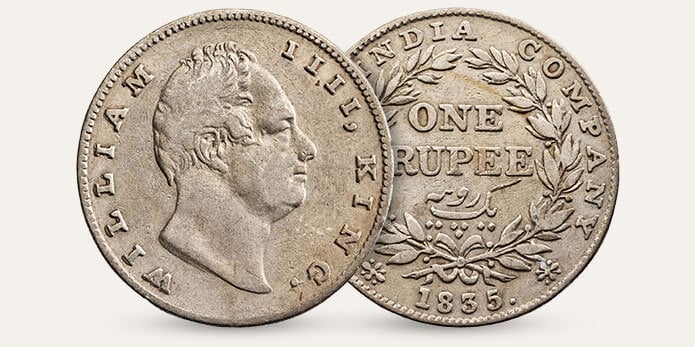
William IV (r. 1830–37)
The administration of British India was divided into three presidencies that had developed from The East India Company’s factory bases in Madras (Chennai), Bombay (Mumbai) and Calcutta (Kolkata). In 1835, the Uniform Coinage Act was passed, whereby the three British presidency coinages were merged into a single uniform coinage across British India. Silver rupees of 180 troy grains weight and 11/12th fine in terms of purity became the sole legal tender across British India. The rupees of The East India Company bore William IV’s effigy created by William Wyon RA, Chief Engraver at The Royal Mint, on the obverse, whilst the reverse featured ‘EAST INDIA COMPANY’ engraved alongside the words ‘ONE RUPEE’ surrounded by a wreath beneath a crown, and the denomination written in Persian.
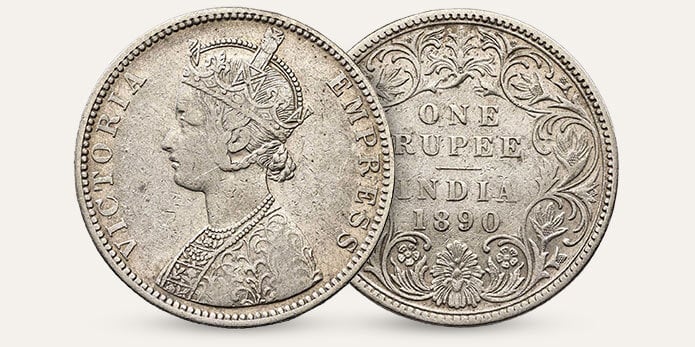
Queen Victoria (r. 1837–1901)
After the Great Indian Revolt of 1857, the British government disbanded The East India Company and took direct control of India; the first Indian coinage under the British Crown was issued in 1862. In 1877, Prime Minister Benjamin Disraeli had Queen Victoria proclaimed as Empress of India. This title was a gesture to link the monarchy with the empire, ease tensions, and bring India closer to Britain. In November 1876, directions were given to the Mint Masters of Bombay and Calcutta that ‘VICTORIA EMPRESS’ should replace ‘VICTORIA QUEEN’ on all coins struck on or after 1 January 1877, and that new dies would need to be urgently prepared
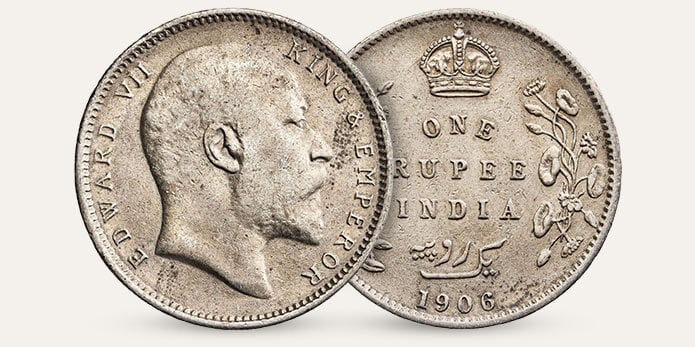
Edward VII (r. 1901–10)
The obverse of Edward VII’s rupees feature his ‘bare head’ portrait by George William De Saulles, Chief Engraver at The Royal Mint between 1892 and 1903. The portrait was not popular in India as many believed the king should look more regal and wear a crown. As a result, Edward VII earned the nickname ‘ganja raja’ or ‘bald king’. Later in his reign, in 1906, a cupro-nickel coin with a denomination of one Anna was introduced showing Edward VII wearing full royal regalia, including a crown. A proposal was made to include this crowned portrait on rupees; patterns were made, but the king died before these coins could be released
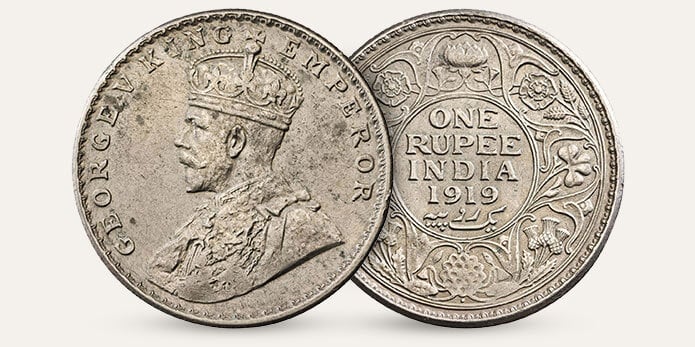
George V (r. 1910–36)
For George V’s rupees, a more ornate design was made for the reverse featuring an outside circle that included a wreath made of roses, thistle, shamrock leaves and lotus flowers. This design combined emblems of the United Kingdom with India’s national flower, the lotus, as a symbol of unity. The obverse shows Bertram Mackennal’s portrait of the king. A shortage of silver due to the First World War led the British government to begin issuing paper currency with the values of 1 rupee and 2.5 rupees for the first time; silver coins of smaller denominations were issued in
cupro-nickel.
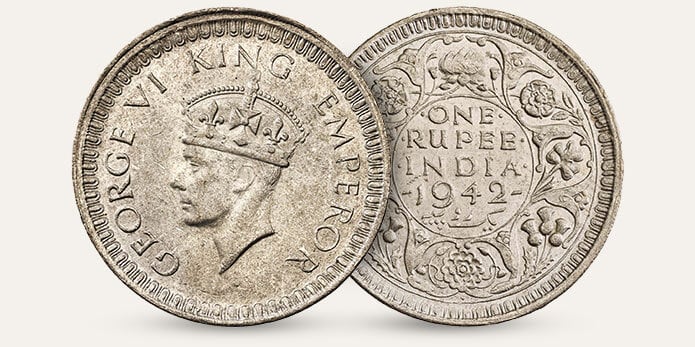
George VI (r.1936–52)
George VI was the last British monarch to appear on the obverse of Indian rupees. The title ‘Emperor of India’ was abolished on 22 June 1948, when, under the Indian Independence Act 1947, George VI made a royal proclamation that the words ‘Emperor’ be omitted from his titles. His reign also saw the issue of the last fully silver rupee in 1939. With the outbreak of war, the coins were issued as 50% silver and 50% nickel, and then finally they were struck using just nickel. As a result, 1939 rupees are very rare as many were melted down after the debasement that quickly followed its issue.
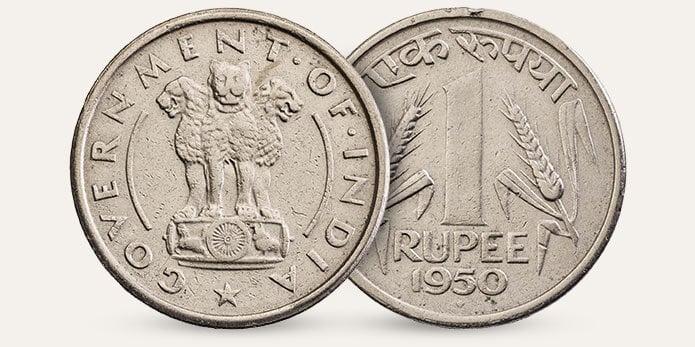
Independence
From 1947, British Indian coins were used as a frozen currency until coins in the name of the Republic of India were first issued in 1950. These new coins all featured the national emblem of the republic on the front, an adaptation of the Lion Capital which was originally found atop the famous column erected by the Emperor Ashoka of the Mauryan dynasty in the third century BC. Symbolising power, courage, pride and equanimity, the original includes four Asiatic lions standing back to back, with only three visible in the 2D design, as the fourth is hidden.
Unlike the other rupees in this set, the 1950 rupee was struck using nickel rather than silver. Due to inadequate supplies of silver on the open market and prevailing high prices, a decision was made in 1947 to abandon the use of silver for the coinage.
Own a piece of history
In conclusion, this remarkable collection of six Indian one-rupee coins offers a captivating window into the rich and storied history of the rupee in India. From its origins as the rupiya under Sher Shah Suri to its evolution during the reign of the Mughals and the transformative period of British India, these coins bear witness to the nation’s journey towards independence. As a numismatist, acquiring this set would be a valuable addition to any collection, as it not only showcases the diverse designs and royal effigies but also serves as a tangible reminder of India’s numismatic heritage. Beyond their aesthetic and historical appeal, these coins possess intrinsic
value as artifacts that embody the economic, cultural, and political forces that shaped India. Owning this collection offers an opportunity to explore and appreciate the fascinating narrative of the Indian rupee, making it a prized possession for collectors and enthusiasts alike.
Specification
| Specification | Value |
|---|---|
| Denomination | Multi |
| Quality | Circulating |
| Year | 1950 |
| Pure Metal Type | Silver |
| Condition | Minimum of Fine |
| Specification | Value |
|---|
